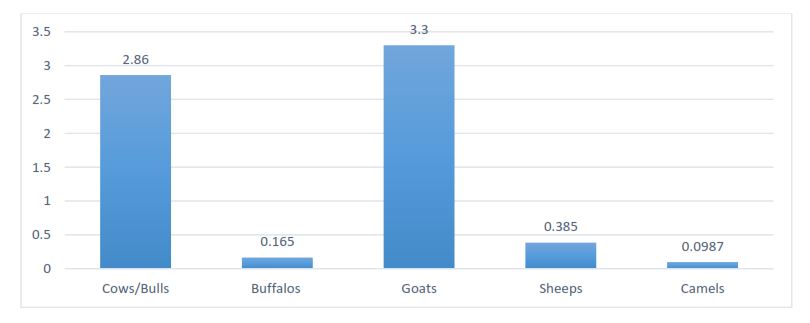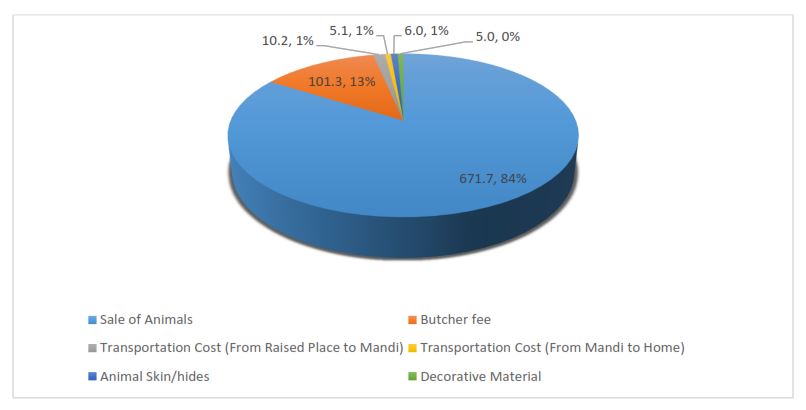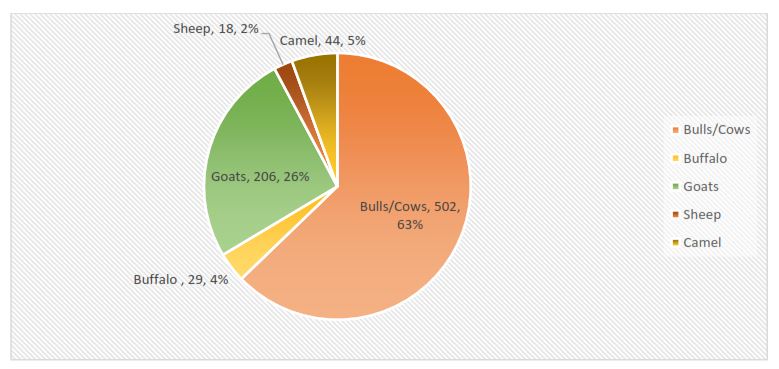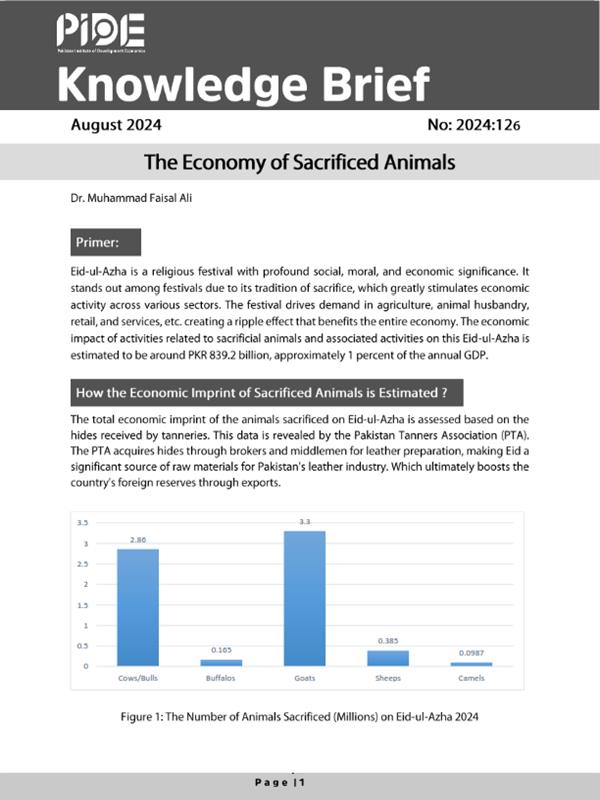
Pakistan Institute of Development Economics
- Home
Our Portals
MenuMenuMenuMenuMenuMenuMenu - ResearchMenuMenuMenuMenuMenuMenuMenu
- Discourse
- The PDR
- Our Researchers
- Academics
- Degree Verification
- Thesis Portal
- Our Portals
The Economy of Sacrificed Animals
Primer:
Eid-ul-Azha is a religious festival with profound social, moral, and economic significance. It stands out among festivals due to its tradition of sacrifice, which greatly stimulates economic activity across various sectors. The festival drives demand in agriculture, animal husbandry, retail, and services, etc. creating a ripple effect that benefits the entire economy. The economic impact of activities related to sacrificial animals and associated activities on this Eid-ul-Azha is estimated to be around PKR 839.2 billion, approximately 1 percent of the annual GDP.
How the Economic Imprint of Sacrificed Animals is estimated?
The total economic imprint of the animals sacrificed on Eid-ul-Azha is assessed based on the hides received by tanneries. This data is revealed by the Pakistan Tanners Association (PTA). The PTA acquires hides through brokers and middlemen for leather preparation, making Eid a significant source of raw materials for Pakistan’s leather industry. Which ultimately boosts the country’s foreign reserves through exports.

Figure 1: The Number of Animals Sacrificed (Millions) on Eid-ul-Azha 2024
According to the PTA, approximately 6.8087 million animals were sacrificed this year. There is a 9.7 percent increase in the number of animals sacrificed compared to the 6.18 million animals sacrificed during Eid-ul-Azha in 2023, may be due to less significant inflation effects as compared to last year. This total number of animals sacrificed include 2.86 million cows and bulls, 0.165 million buffaloes, 3.3 million goats, 0.385 million sheep, and around 0.0987 million camels, as shown in Figure 1.
Economic Impact of Sacrificed Animals by Type of Activity:
While estimating the economic activity generated through sacrificing animals, we consider the number of animals sacrificed, the price per animal, butcher fees, transportation costs, the price of hides, and the cost of decorative materials for bulls/cows, buffalo, goats, sheep, and camels.
The sale of animals is the largest economic activity with a share of 84 percent of total economic activity. The economic imprint of the sale of animals was about PKR 671.7 billion, followed by butcher fees at PKR 101.3 billion with a share of 13 percent in total economic activity. Transportation costs, both from the raised place to the market and from the market to home, add up to PKR 10.2 billion and PKR 5.1 billion, respectively. The revenue from animal hides is PKR 6 billion, and the estimated expenditure on decorative materials is about PKR 5 billion.

Figure 2: The Total Economic Impact by Type of Activity
The detailed estimation of each activity is explained below:
- The total economic impact of the sale of animals is estimated with average prices of PKR 400,000 per camel, PKR 150,000 per bull, cow, and buffalo, PKR 50,000 per goat, and PKR 35,000 per sheep. Therefore, this activity collectively generated an estimated economic circulation of approximately PKR 671.7 billion.
- Eid provides employment opportunities to many, with butchers being the most significant beneficiaries. The butcher’s services were counted for an average of PKR 20,000 for cows and buffaloes, PKR 10,000 for goats and sheep, and PKR 40,000 per camel. Hence, this activity generated a circulation of approximately PKR 101.3 billion.
- Transportation costs are divided into two categories. Transportation charges from the place where animals are raised to the market were around PKR 2,000 per cow or buffalo, PKR 1,000 per goat or sheep, and PKR 5,000 per camel. This activity generated a circulation of about PKR 10.2 billion.
- Similarly, transportation from the market to home costs PKR 1,000 for cows and buffalo, PKR 500 for goats and sheep, and PKR 2,000 for camels. This activity generated about PKR 5.1 billion in economic activity.
- The average price of bull or cow skin/hide was PKR 1500, and PKR 1600 for buffalo skin. Whereas the average prices for goat, sheep, and camel skins were PKR 425, PKR 45, and PKR 550, respectively. Collectively, their contribution to the entire economic activity was around PKR 6 billion.
- The decorative materials for sacrificial animals constitute another notable economic activity. Assuming an expenditure of PKR 1,000 per large animal and PKR 500 per goat or sheep, this activity contributed approximately PKR 5 billion.
- Additional activities such as feeding (including the sale of fodder), shelter rent in mandi, market entry fees for animals, the business of knives and meat chopping blocks, the sale and purchase of other animal body parts, and services like beef mince preparation and animal foot preparation further boost the economy. These combined activities are assumed to account for 5 percent of the total economic activity, roughly PKR 36.13 billion.
Therefore, the total economic activity through sacrificed animals and associated activities was around PKR 839.2 billion during Eid-ul-Azha 2024.
Economic Impact by Animal Type:
A look at the total economic activity generated by the type of animals revealed that the sacrifice of Bulls and Cows was the highest economic activity around PKR 502 billion, followed by goats at PKR 206 billion. Buffalo, sheep, and camels generated an economic activity of about PKR 29 billion, PKR 18 billion, and PKR 44 billion, respectively.

Figure 3: Economic Activity by Animal Type (PKR Billions)
Benefits Transferred to the Rural Economy:
A large number of people in rural areas raise the animals that are ultimately sacrificed on Eid-ul-Azha. Although commercial raising of sacrificial animals does occur, it is on a very limited scale. A consultation with experts has revealed that less than 5 percent of the total animals sacrificed on Eid are commercially raised. These commercially raised animals are priced 2 to 5 times higher than the average market prices due to higher production costs. Hence, about 95 percent of the animals are brought to urban markets from rural areas. Usually, middlemen purchase these animals from rural areas and bring them to urban markets for sale. The cost of raising these animals is borne by the rural populace. However, raising these animals costs much less than commercially raised animals for several reasons:
- Firstly, rural farmers often use traditional and cost-effective methods, relying on local resources and homegrown feed, which reduces expenses.
- Secondly, labor costs are lower in rural areas as family members typically contribute to animal care.
- Thirdly, rural areas benefit from lower land costs and minimal infrastructure expenses.
- Fourthly, rural farmers often utilize communal grazing lands, reducing the need for purchased fodder.
- Lastly, the absence of advanced technology and intensive management systems in rural farming keeps production costs significantly lower compared to commercial operations.
Benefits transferred to Charity, Religious, and Political organizations:
Numerous charity organizations, religious institutions, and political parties have benefited from collecting hides from people and selling them to tanneries, earning millions of rupees. However, their revenue stream has been severely impacted in recent years due to continuously falling hide prices due to reduced demand. As a result, many Pakistani charities have been compelled to seek alternative fundraising sources and methods to sustain their operations.
Benefits to the Leather Industry:
The sacrifice of animals during Eid-ul-Azha has a profound impact on Pakistan’s leather industry. This festival generates a substantial influx of raw materials (almost 30 percent), primarily hides, essential for leather production. This influx supports the leather industry’s supply chain, contributing significantly to Pakistan’s leather exports of about USD 0.86 billion, in 2022-23 and boosting foreign reserves. However, the industry’s revenue stream has faced challenges in recent years due to falling hide prices and declining demand. Further, almost 20 percent of hides collected on each Eid are wasted due to poor management. Despite these challenges, Eid-ul-Azha remains a crucial event for the leather industry, ensuring a steady supply of raw materials necessary for production and export activities.
Conclusions:
The economic impact of Eid-ul-Azha on Pakistan’s economy is multifaceted. This religious festival, which involves the sacrifice of 6.8 million animals, catalyzes a substantial influx of economic activity, estimated at PKR 839.2 billion, approximately 1 percent of the annual GDP. This considerable economic footprint underscores the festival’s vital role in stimulating various sectors, including agriculture, animal husbandry, retail, and services. The ripple effect from these activities extends across the entire economy, benefiting diverse stakeholders.
The sale of sacrificial animals constitutes the most significant share of economic activity, generating PKR 671.7 billion. Butchers, transportation providers, and suppliers of decorative materials also earn a substantial economic share. Employment opportunities proliferate, particularly for butchers, whose services are in high demand during the festival. Additionally, transportation costs and the sale of hides contributed notable amounts to the overall economic circulation. Apart from the sale of animals, all other related activities collectively generated an economic activity amounting to PKR 167.55 billion. Lastly, the leather industry remains a significant beneficiary of Eid-ul-Azha. The influx of raw materials from sacrificed animals provides a critical supply for tanneries, bolstering Pakistan’s leather exports and enhancing foreign reserves.
Appendix:
Table 1: Animals Sacrificed and Associated Prices
| Activities | Cows | Buffalo | Goats | Sheep | Camel |
| Animals Sacrificed (Millions) | 2.86 | 0.165 | 3.3 | 0.385 | 0.0987 |
| Price/Animal (PKR) | 150000 | 150000 | 50000 | 35000 | 400000 |
| Butcher Fee/Animal | 20000 | 20000 | 10000 | 10000 | 40000 |
| Transportation Cost/Animal (From Raised Place to Mandi) | 2000 | 2000 | 1000 | 1000 | 5000 |
| Transportation Cost/Animal (From Mandi to Home) | 1000 | 1000 | 500 | 500 | 2000 |
| Price/Hide | 1500 | 1600 | 425 | 45 | 550 |
| Decorative Material/Animal | 1000 | 1000 | 500 | 500 | 1000 |
Source: Author’s Estimation
Table 2: Economic Footprint Generated by Type of Activity and Animal Type (PKR Billion)
| Cows | Buffalo | Goats | Sheep | Camel | |
| Sale of Animals | 429.00 | 24.75 | 165.00 | 13.48 | 39.48 |
| Butcher fee | 57.20 | 3.30 | 33.00 | 3.85 | 3.95 |
| Transportation Cost (From Raised Place to Mandi) | 5.72 | 0.33 | 3.30 | 0.39 | 0.49 |
| Transportation Cost (From Mandi to Home) | 2.86 | 0.17 | 1.65 | 0.19 | 0.20 |
| Animal Skin/hides | 4.29 | 0.26 | 1.40 | 0.02 | 0.05 |
| Decorative Material | 2.86 | 0.17 | 1.65 | 0.19 | 0.10 |
Source: Author’s Estimation



